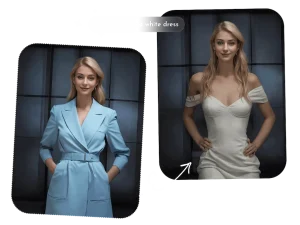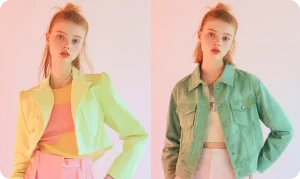Fast fashion, second-hand, vintage, and questionable hand-me-downs of your cousin, forget it all at the moment. We are going to zoom in on a place where the convergence of pixels and personality occurs and your closet is not just three feet of hanging space. Digital personae are flowering, and in the dead center? The technology that will change the game is known as change outfit ai. We are referring to algorithms that have the ability to change your T-shirt to a tux in less the time it requires to zip up you jeans. This sounds like Murphy in a Black Mirror episode, does it not? However, it is already a part of the everyday lives in the virtual spaces.

The Science Behind Changing Outfits with AI
So What Does the Outfit-Changing AI Really Do?
That is, let us take a look at what is going under the hood. Think of sharing selfie on an application. Soon after, a mere couple of clicks, and you are padding about in a vintage 70s blazer or in a metallic jumpsuit that would not look out of place in a space opera movie. That science? It is convolutional neural networks, generative adversarial networks, how they say, GANs, getting the work done. They sample the pixels of your photo, identify your pose, lighting and outlines and place over it clothing of a huge database, constantly being updated.
The less graphics there is, the more there is going on. These machine learning models study drape, fit, and even shadow to generate life-like output. AI also has the ability to customize your outfit according to the proposed fashion or according to your preference saved preferences. The cloth does not simply stick on it but moves with elbows, lifts over the knees. Such a deception would cause any magician jealous.
Try Before You Buy-Risk-Free Stiling
That is online shopping with a bit of Harry Potter magic. Once, people bought things online and strained to read the size charts and wished that it would behave in some way and fit. Even, nowadays, using AI styling assistant, you have the opportunity to check yourself out in that flirty leopard print or provocative neon hoodie before hitting the buy button. No salesperson to perceive your eighth return in the current month. No embarrassing selfies in poor quality changing rooms.
These tools can be used by influencers, content creators, and real people to experiment, exchange looks, or make thematic content, and these tools have never even opened their closet. Movie star looks are being borrowed by cosplayers. Players are able to use their faces and know how good armor suits them and then go ahead spending money on some new skins. It is somewhat like opening a treasure chest every day; you find your personal style suddenly in the virtual worlds.
Fashion without Limit: Digital Identities
Gone are the times where you have been pegged in by what you have in your real hanger rack. The digital dressing allows you to avoid weather, laundry day or financial limitations. You can wear something that reads beach to video call in the middle of December and wear Gothic Victorian during a virtual book club- no biggy. (Literally.)
Get to know your Avatar–Your Style, your Rules

No more the embarrassing moments of online avatars that resembled cartoonish characters that are of square shape. Today, AI-enhanced apps and services provide you with avatars that truly resemble your personality in the real-life or the most daring fashion dreams. Whether you want your avatar to dress in galaxy-print overalls to a corporate zoom or fantasy robe of elves, you can now do so. Such actions provide them with new creative ways of expressing themselves, and frankly speaking, lots of juvenile mess.
What we will assume is that you are a big fan of sustainability. AI that helps you change outfits can make you averse to the siren of fast fashion. The online virtual makeovers fulfil a fashion itch without guilt on the environment. It is like the act of thrift shopping except there is an abundance of choice and no scary stains.
Personalized Stylists at Scale Brands and Marketers
It is Bigger than Fun and Games
Retailers, marketing gurus and stylists are moving in droves to virtual try ons and AI-produced lookbooks. The biggest fashion giants in the world such as Gucci, Zara, Nike have been implementing the functionality of virtual try ons in their online shopping. There are also dynamic outfit suggestions to customers, which is synonymous with what they like, recently clicked or even depending on the weather outside.
AI is not about replacing pants, that is about studying millions of looks in pictures and by tastes of users creating outfits which will work well on your body and in your schedule. A 2023 McKinsey report shows that with AI-powered visualizations companies had increased customer satisfaction by 19 percent and a 13 percent reduction in product returns. That is fewer wastes and more smiles.
Social Media is being Redecorated

Tiktokkers, Fashion influencers, and Digital artists are using AI to remix their style, experiment with viral fads or get sponsorships by large companies. You will see marine-photo shoots where a single image produces seven days of unique materials, and all of them have a changed outfit, but it does not resemble the poorest remake. The popularity of the Outfit Change challenge in TikTok was a bombshell, as the AI feature allowed creators to change their outfits during the video with a finger snap.
The Technical Wizards: Never ending Change
With new technologies of image segmentation, motion tracking, and artificial intelligence learning, the results are now more precise, more detailed, and, to be frank, a lot less glitchy than the original examples. The more realistic the virtual tries are the better the technology is. Machine learning algorithms are eating through billions of fashion images, and learning non-stop. Every application sharpens the understanding of the AI concerning the movement of cloth, the matching of color and the realistic texture.
Such projects as DeepFashion (open-source) or startups, such as Reface or Wombo, are pushing the envelope. Some have more advanced tools that allow 3D previews of garments (we can look like we are twirling, spinning or moonwalking in the digital clothing before handing over the money).
